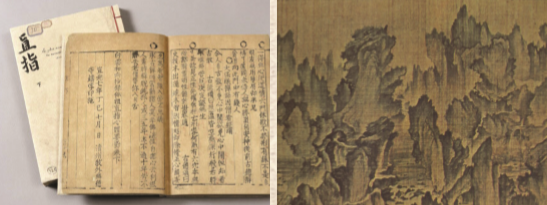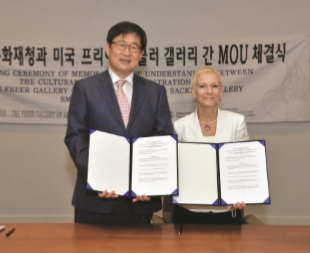This year marks the 70th anniversary of the outbreak of the Korean War. Due to the Korean War, many Korean cultural heritages were taken to foreign countries. In fact, there are still about 190,000 Korean heritages in 21 countries. The Sungkyun Times (SKT) investigates the current state of the Korean cultural heritages, difficulties in the repatriation of the heritages, and possible solutions.

Korean Cultural Heritages Ove rseas
History of Stolen Cultural Heritages
The three main periods when cultural heritages and relics were taken away by intruders are the Korean War, the end of the Joseon Dynasty, and the Japanese colonial era. During those periods, Korea experienced national crises. The end of the Joseon Dynasty was the time when the world powers inroaded Korea competitively. Consequently, heritages were mostly taken to the West, including the United States (US), Russia, France, and Germany. For example, the ancient books in the French National Library were originally housed in Oegyujanggak on Ganghwado Island in Korea, but French soldiers looted them during the French campaign against Korea in 1866. Sometimes diplomats in Korea collected Korean antiques and ancient books and took them out to foreign countries. During the Japanese colonial era, there were frequent thefts and tomb robberies of heritages across the country, as well as extortion by powerful figures, such as the Japanese Governor-General of Korea. The Japanese Governor-General of Korea intervened in stealing the Odaesan archive of the Annals of the Joseon Dynasty, which were written during the Joseon Dynasty. During the Korean War and immediately after the war, many relics were also taken to the US.
Status of the Cultural Heritages Abroad
In 1992, the government began campaigns to retrieve cultural heritages, and the National Research Institute of Cultural Heritage (NRICH) began investigating overseas cultural heritages in eight countries, including the US, European countries, and Japan. In 2012, the Overseas Korean Cultural Heritage Foundation (OKCHF) was established, so that detailed research could be conducted around the world. As of 2019, about 10,000 cultural heritages have been returned. For example, Uigwe, the royal protocols of the Joseon Dynasty, which were located in the French National Library, were returned in 2011 in the form of a permanent lease, and Queen Munjeong’s royal seal, which was taken by the US military during the Korean War, was returned in 2017.

However, there are still many cultural heritages that have not been returned yet. According to the OKCHF, 21 countries have 193,136 Korean cultural heritages, and Japan has 42.4% of them. The US follows by 27.5% and China by 6.7%. Important cultural heritages in foreign countries include Dream Journey to Peach Blossom Land and Jikji. Dream Journey to Peach Blossom Land was painted by Ahn Gyeon, who depicted Prince Anpyeong’s dream of strolling in a peach garden. Tenri University in Japan presently owns the picture, and it is designated as Japan’s Important Cultural Property No. 1152. It is estimated that it was taken to Japan around the 19th century. Jikji, the world’s oldest existing book printed with movable metal type, was claimed by French diplomat Collin de Plancy and moved to Paris. The French National Museum currently owns it.
Difficulties in Retrieval
Limits of International Convention
UNESCO adopted the Convention on the Means of Prohibiting and Preventing the Illicit Import, Export and Transfer of Ownership of Cultural Property in 1970. Under this convention, the government recognizes ownership of cultural heritages acquired, exchanged, given, or purchased under the consent of the competent authorities of the original country. It also recommends that countries that took cultural heritages from other countries introduce appropriate certificates to prove that they have been authorized to take out the heritages. However, this convention does not have any significant power and only applies to transactions after the 1970s, when the convention was signed. In addition, there are four categories of heritages that can be redeemed in international society: heritages that were taken during the war, heritages that were stolen or illegally taken out of the country, heritages that were transferred during the colonial era or foreign occupation, and ownership of heritages was changed when a country was separated into several countries, such as the former Soviet Union. The UNESCO Convention is only applied to the second category. In 1995, the UNIDROIT Convention on Stolen or Illegally Exported Cultural Objects provided a more advanced avenue. It is an international agreement to return stolen or illegally taken cultural heritages to the original country or the original owner without acknowledging the acquisition of good faith. However, this convention also does not apply to cases that occurred before the convention, and many countries, including Korea, Japan, the US, and the United Kingdom, have not joined. There is no international agreement on the outflow of cultural heritages in the colonial era. Therefore, the heritages of Korea are being returned through negotiation, donation, and purchase between governments of directly involved countries.
Lack of Justification for Ownership
To get the cultural heritages back, it is necessary to check whether the heritages were looted or taken through illegal routes, or whether they were owned through legitimate routes such as gifts, donations, or purchases. In the process, legal or institutional differences between countries can be an obstacle. If the owner did not know that the heritage was looted or illegal, ownership is recognized as an “acquisition of good faith”, which is the reasoning France and Japan often fall back on. In this case, the only way to bring the heritage in is through donation or purchase. Another problem is that it is harder to figure out how cultural heritages were taken out of a country as time passes. In 2012, a group of thieves stole the Standing Bronze Buddha Statue and the Seated Avalokitesvara Statue from Daemado in Japan. Thieves tried to sell the statues in Korea, but the police caught them and seized both. At that time, there was a disagreement between the opinion that there is no need to return them since they are originally Korean Buddha statues and that they should be returned because they were illegally taken out. In the end, the Standing Bronze Buddha Statue, which did not have a definite route to Japan, and had no group claiming ownership, was returned to Japan. The trial of the Seated Avalokitesvara Statue, which is in dispute over ownership with Buseoksa Temple in Seosan, is currently underway. Even if it is a Korean cultural heritage, it is hard to claim ownership if Korea fails to prove how it was taken out and where it was originally located.
Ways to Protect Korean Heritages
Making a Bilateral Treaty
Oh Mi-Young, a Dongguk University professor of law, proposes to make a bilateral treaty to get heritages back in her thesis International Legal Issues on Korean Buddhism Cultural Property Repatriation and some Policy-oriented Proposals. In multilateral convention, it is difficult to contain details, because it must bring the common interests of many countries together. The new international agreement is not likely to be made because of conflicting interests between the former colonial powers and the former colonies. A bilateral treaty can be more effective on certain issues than a multilateral treaty because it can contain specific interests between the two countries. Representatively, South Korea received 1,432 pieces back in 1965 under the Treaty on Basic Relations between Japan and the Republic of Korea. However, since the main goal of Korea was to achieve economic development with the property claims at that time, many experts evaluate that as a regretful agreement regarding the art repatriation. In future agreements with other countries, it is necessary to closely examine the problems of the Korea-Japan treaty and come to an agreement that can bring about positive results for the nation.

Operating Two-tracks
Retaking cultural heritages is the best way, but it is often impossible. Under these circumstances, the government can operate two ways to promote Korean culture: reclaiming the heritage and using it locally. Cultural heritages, which are not revealed by institutions or individuals concerned about being the target of the cultural heritage recovery campaigns, can be used to promote Korean culture. Ji Gun-gil, former chairman of the Overseas Korean Cultural Heritage Foundation, said it would focus on how to utilize and promote Korean cultural heritages locally. For example, if a heritage is not being properly utilized due to damage, Korea can provide local museums with a budget for preservation and exhibition. The reality is that Korea’s heritages are less recognizable than those of Japan and China. It allows foreign museums and art galleries to set up Korean Pavilions or Korean Rooms, allowing cultural heritages to promote Korea. For instance, Freer Gallery of Art and Arthur M. Sackler Gallery in the US received funding from the Cultural Heritage Administration (CHA) and created a comprehensive information website for Korea Buddhist paintings in 2019 after seven years of effort. There was a thorough investigation of 16 Korea Buddhist paintings housed in eight US museums, high-resolution image photography, expert artwork commentary, and international symposiums. The Cultural Heritage Administration is planning to carry out joint research with the Freer Gallery of Art and Arthur M. Sackler Gallery for the continued preservation of Korea Buddhist paintings. Nevertheless, the government can push ahead with a return if heritage is a national treasure-class or has high cultural value in research and art history.
There has long been an imperialistic logic-influenced belief that a country which plundered heritages had better preservation capabilities than the plundered countries. However, this is a relic of the old era. Korea is truly an advanced country now. Furthermore, cultural heritages containing the spirit of our ancestors will show the dignity and pride of our country. The SKT hopes that the cultural heritages of Korea around the world will be in their proper place someday.
